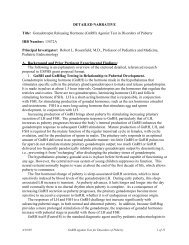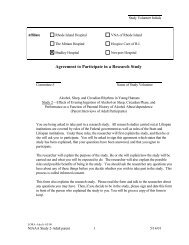VIROPTIC Ophthalmic Solution, 1% Sterile - HHS Archive
VIROPTIC Ophthalmic Solution, 1% Sterile - HHS Archive
VIROPTIC Ophthalmic Solution, 1% Sterile - HHS Archive
You also want an ePaper? Increase the reach of your titles
YUMPU automatically turns print PDFs into web optimized ePapers that Google loves.
Pediatric Use: Safety and effectiveness in pediatric patients below six years of age have not<br />
been established.<br />
Geriatric Use: No overall clinical differences in safety or effectiveness have been observed<br />
between elderly and other adult patients.<br />
ADVERSE REACTIONS: The most frequent adverse reactions reported during controlled<br />
clinical trials were mild, transient burning or stinging upon instillation (4.6%) and palpebral<br />
edema (2.8%). Other adverse reactions in decreasing order of reported frequency were<br />
superficial punctate keratopathy, epithelial keratopathy, hypersensitivity reaction, stromal edema,<br />
irritation, keratitis sicca, hyperemia, and increased intraocular pressure.<br />
OVERDOSAGE: Overdosage by ocular instillation is unlikely because any excess solution<br />
should be quickly expelled from the conjunctival sac.<br />
Acute overdosage by accidental oral ingestion of <strong>VIROPTIC</strong> has not occurred. However, should<br />
such ingestion occur, the 75 mg dosage of trifluridine in a 7.5 mL bottle of <strong>VIROPTIC</strong> is not<br />
likely to produce adverse effects. Single intravenous doses of 1.5 to 30 mg/kg/day in children<br />
and adults with neoplastic disease produce reversible bone marrow depression as the only<br />
potentially serious toxic effect and only after three to five courses of therapy. The acute oral<br />
LD 50 in the mouse and rat was 4379 mg/kg or higher.<br />
DOSAGE AND ADMINISTRATION: Instill one drop of <strong>VIROPTIC</strong> <strong>Ophthalmic</strong> <strong>Solution</strong>, <strong>1%</strong><br />
onto the cornea of the affected eye every 2 hours while awake for a maximum daily dosage of<br />
nine drops until the corneal ulcer has completely re-epithelialized. Following<br />
re-epithelialization, treatment for an additional 7 days of one drop every 4 hours while awake for<br />
a minimum daily dosage of five drops is recommended.<br />
If there are no signs of improvement after 7 days of therapy or complete re-epithelialization has<br />
not occurred after 14 days of therapy, other forms of therapy should be considered. Continuous<br />
administration of <strong>VIROPTIC</strong> for periods exceeding 21 days should be avoided because of<br />
potential ocular toxicity.<br />
HOW SUPPLIED: <strong>VIROPTIC</strong> <strong>Ophthalmic</strong> <strong>Solution</strong>, <strong>1%</strong> is supplied as a sterile ophthalmic<br />
solution in a plastic Drop Dose dispenser bottle of 7.5 mL (NDC 61570-037-75-the old number<br />
was NDC 0173-0968-02).<br />
Store under refrigeration 2 to 8C (36 to 46F). <br />
ANIMAL PHARMACOLOGY AND ANIMAL TOXICOLOGY: Corneal wound healing<br />
studies in rabbits showed that <strong>VIROPTIC</strong> did not significantly retard closure of epithelial
















